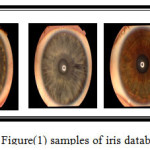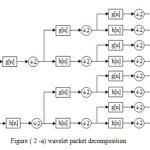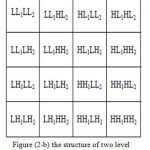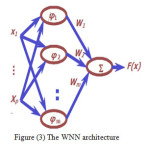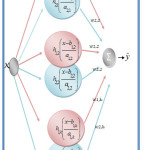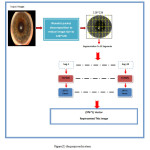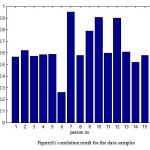INTRODUCTION
Bio metrics is the science and technology of measuring and analyzing biological data of human body The term Bio metrics relates to the measurement (metric) of characteristics of a living (Bio) thing in order to identify a person. Bio metrics uses various physiological or behavioral characteristics. Common physiological bio metric measurements include fingerprints, hand geometry, retina, iris, facial images etc. While common behavioral bio metric measurements include signatures, voice recordings, keystroke rhythms etc.[1] in this paper the iris is chooses .The iris is the most unique feature visible on the human body. No two irises are the same – even identical twins have different iris patterns. The abundance of detail in the iris, its variability and lack of genetic dependence, and its accessibility for imaging without physical contact all make the iris an excellent personal identifier, extracting a feature set from the acquired data, and comparing this set against to the template set in the database[2]. Wavelet packets represent a generalization of multi resolution decomposition. In the wavelet packets decomposition, the recursive procedure is applied to the coarse scale approximation along with horizontal detail, vertical detail, and diagonal detail, which leads to a complete binary tree[3]. A wavelet neural network, which logically connects an artificial neural network with wavelet use wavelet functions as hidden neuron activation functions . The training process of wavelet networks is similar to that of RBF networks[4]. two activation wavelet networks similar to wavelet networks but with two scaling and wavelet functions.
iris
The iris is the coloured ring of textured tissue between the pupil and the white of the eye. The formation of each iris is stabilized by the age of two and even twins have different iris patterns. Irises can only be altered by surgery, and it is therefore very
difficult to impersonate someone based on this characteristic. This textured tissue of the iris possesses a unique mesh-like structure of features forming a complex pattern .The pattern can contain some of the following features: arching ligaments, ridges, crypts, corona, freckles, pits, furrows ,straights, and rings[5]. In this paper we use Palacký University iris database [6] ,some samples shown in fig(1).
Wavelet Packets (WP)
The wavelet packet method is a generalization of wavelet decomposition that offers a richer range of possibilities for signal analysis and which allows the best matched analysis to a signal. It provides level by level transformation of a signal from the time domain into the frequency domain[7]. It is calculated using a recursion of filter decimation operations leading to the decrease in time resolution and increase in frequency resolution. The WP divides not only the low, but also the high frequency subband. In wavelet analysis, a signal is split into an approximation and a detail coefficient. The approximation coefficient is then itself split into a second level approximation coefficients and detail coefficients, and the process is repeated. In wavelet packet analysis, the details as well as the approximations can be split. When the wavelet transform (WT ) is generalized to the WP, not only can the lowpass filter output be iterated through further filtering, but the highpass filter can be iterated as well so it offers a more complex and flexible analysis.fig (2 (a , b)).
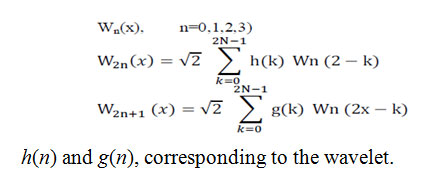
h(n) and g(n), corresponding to the wavelet.
W0(x) = Ф(x) is the scaling function and W1(x) =Ψ(x) is the wavelet function.
Wavelet neural network
Wavelet Networks attempt to combine the properties of the Wavelet decomposition , along with the characteristics of neural networks [8]. Their structure relies on the aforementioned principles underlying non-linear function approximation. The idea of using wavelets in neural networks has been proposed recently by Zhang and Benveniste , Pati and Krishnaprasad [9]. The network architecture is shown in Fig (3),Wavelet Neural Networks (WNNs) has
recently attracted great interest, because they are universal approximations, it’s achieved faster convergence than Radial Basis Function Neural Networks (RBFNN) and are capable to deal with the problems of “curse of dimensionality”. In addition, WNN are generalized RBFNN [10]. The structure of the WNNs is similar to the RBFNNs, except the radial basis function is replaced with ortonormal basis functions Wavelet Networks have the advantage, that the wavelet coefficients are directly related data stream through the wavelet transform. In addition, the parameters of the wavelets in the WNs are subject to optimization. Wavelet Networks and Neural Networks (in particular, Radial Basis Functions) are very often used as non-parametric estimators in the fields of function approximation and system modeling. Wavelet Networks (WNs) are an implementation of Wavelet Decomposition, a technique which has recently emerged as a powerful tool for many applications in the field of signal processing, such as data compression and function approximation. The Two Activation Function Wavelet Network (TAFWN) is very similar to wavelet Network (WN) but have some important differences, whereas wavelets has an associated scaling function Ф (t) and wavelet function Ψ (t) TAFWN has two scaling Ф1(t), Ф2(t) and two wavelet functions Ψ1(t), Ψ2(t) Accordingly, there are two scaling filters and two wavelet filters. in This paper using the combination of the wavelet packet Transform (WPT) and Two Activation Function Wavelet Network (TAFWN), fig(4) explain how TAFWN work. The result obtained by the suggested method is promising and will shed some light to encourage researchers to adopt this technique [11].
5.The proposed work
5.1. Two Activation Function Wavelet Networks Algorithm
The TAFWN architecture approximates any desired image y by generalizing a linear combination of two set of daughter wavelets h1,ap(x) and h2ab Where the daughter h1,ap(x) and h2ab are generated by dilation, a , and translation, b[2] from two mother wavelets h1 (t) and h2 (t) where

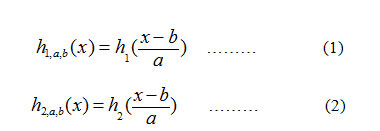
where
a : Dilation factor, with > 0.
b: Translation factor.
x: pixel value of the image.
A TAFWN is a 3-layers feed forward neural network. First the TAFWN parameters, dilation a’s, translation b’s, and weight w’s should be initialized, and the desired sets of data, the input signal x is the pixel value, the desired output (target) y, the number of scaling functions p (p=2 in this work) and the number of wavelons k are given. Assuming that the network output function satisfies the admissibility condition and the network sufficiently approximates the target. The approximated signal of the network can be represented by equation:

x is the pixel value of the image.
wj,i is the weight coefficients between hidden and output layers.
j=1,2,…, p. p=2: a number of scaling functions.
i=1,2,…, k. k is a number of wavelons.
haj,i, bj,i is a two set of daughter wavelets generated from two mother wavelets
h1,ap(x) and h2a(x) as in equations (1) and (2) respectively.
After constructing the initial TAFWN and after calculating output signal of the network, the training of TAFWN starts. It is further trained by the gradient descent algorithms like least mean squares (LMS) to minimize the mean-squared error. During learning, the parameters of the network are optimized. [12]
The TAFWN parameters wj,i = aj,i and bj,i can be optimized in the LMS algorithm by minimizing a cost function or the energy function, , over all function interval using equation (12).
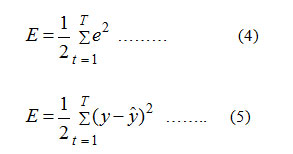
The energy function is defined by equations (4) and (5), is the desired output (target) and is the actual output signal of TAFWN. To minimize the method of steepest descent is used, which requires the gradients

for updating the incremental changes to each particular parameter wj,i = aj,i and bj,i respectively. The gradients of are
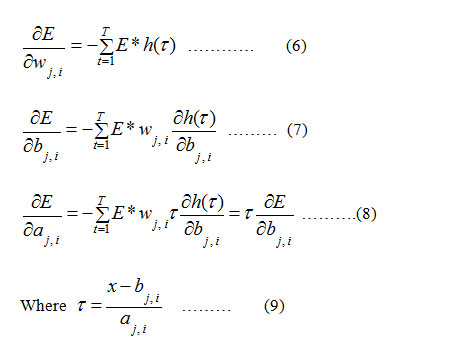
The derivatives of the various wavelet filter with respect to its translation,

The incremental changes of each coefficient are simply the negative of their gradients as in equations (10), (11), and (12). Thus each coefficient w, a and of the network is updated in accordance with the rule given in equations (13), (14), (15).
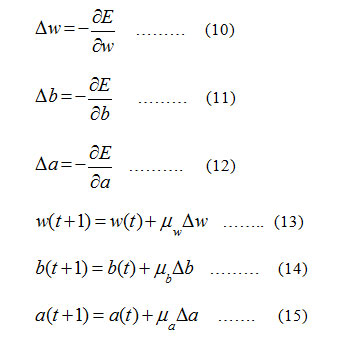
5.2. The Proposed Method For iris Identification:
In this method taken four iris image(2 left, 2 right) for each person with different expression each one of them (256*256) in size and construct in three dimension (256*256*4):
- Take one level of wavelet packet for each image to get reduced size image (to half dimension 128*128 ).
- Segment each image into 32 block .
- The next steps done For each segmenta
Taken segment(1) for image (1) and entered to Two Activation Function Wavelet Network (TAFWN) when the error became small enough, then the training is good and the algorithm is stopped where at this point stored the vector(18*1) (a1,1,a1,2,a1,3,b1,1,b1,2,b1,3,w1,1,w1,2,w1,3,a2,1,a2,2,a2,3,b2,1,b2,2,b2,3,w2,1,w2,2,w2,3) which used it to represent segment (1) of image (1) and then stored it in data base to represent the first person.(in this method used three wavelons(k=3) and wavelet filters ( is POLYWOG4 and is RASP1.
b) Taken segment(2) of image (1) and entered to Two Activation Function Wavelet Network (TAFWN) to get on vector (18*1) which represent segment(2) of image (1) and then stored it in data base to represent the first person.
c) Continue for segments (3…..32) of image (1) of person (1), then get on (576*1) vector represent the 32 segments of the first image of person1 .
d) Continue the above procedure for images(2,3,4) for person (1) then get on a vector (2304*1) represent the four image of person(1).
4. Repeated the step (4) for (15) person images therefore the result data base matrix is (2304*15) and the main block diagram of this proposed method is shown in Fig (5 ).
Matching
The comparison is done between iris features generated for database and test image using correlation approach

where x is the vector for database image and y is the vector for test image while n is the number of elements. This matching score (r) is a final result to determine if the person is genuine or imposter
CONCLUSION
This proposed method is tested on a data base consists of 90 iris images, collected for 15 person with 6 iris images. In the training phase for each person it is required to used 4 iris image per each person (two images for left and two images for right). In the identification phase it is required two images (left and right) of the same person will be used. The identification score for the 15 person under consideration was 86.6% correctly.
Wavelet packet decomposition give good images with minimum size and (TAFWN) given an good feature extraction vector represented the input image where an image (128*128) can be represented by (18*1) vector only. In this method the weights and number of segments is very important because when we test it with (4,8,16) segments for images the accuracy was between (40-55%) .but when we test it with 32 segment the accuracy is 86.6% as explains above.
Future work
1-The proposed work can work with any another biometric (fingerprint, face..).
2-it can work with more segment for image to increase the accuracy identification.
9.Refrences
- P.U.Lahane, Prof. S.R.Ganorkar ,” Fusion of Iris & Fingerprint Biometric for Security Purpose” , International Journal of Scientific & Engineering Research Volume 3, Issue 8, August-2012 1ISSN 2229-5518.
- http://www.eye-controls.com/technology
- Prof. Dr. G. K. Kharate, Dr. Mrs. V. H. Patil , “Color Image Compression Based On Wavelet Packet Best Tree “ , IJCSI International Journal of Computer Science Issues, Vol. 7, Issue 2, No 3, March 2010.
- Shih-Lin Hung1, C. S. Huang2, and C. M. Wen3 , “USING WAVELET NEURAL NETWORK FOR THE IDENTIFICATION OF A BUILDING STRUCTURE FROM EXPERIMENTAL DATA.” 13th World Conference on Earthquake Engineering .Vancouver, B.C., Canada August 1-6, 2004 Paper No. 241.
- Mark Abernethy , “User Authentication Incorporating Feature Level Data Fusion of Multiple Biometric Characteristics” , (2011) Murdoch University.
- http://phoenix.upol.cz/iris/download/ , https://sites.google.com/site/imesecan/databases-used.
- Jagannath Sethi1, Sibaram Mishra2 ,Prajna Parimita Dash3, Sudhansu Kumar Mishra4,Sukadev Meher5 “Image Compression Using Wavelet Packet Tree”, ACEEE Int.J.on signal & image processing,vol,02.No.01,Jan 2011.
- Eduardo Martin Moraud (s0896801) “Wavelet Networks “, February 6, 2009
- Q. Zhang and A. Benveniste” Wavelet networks. In IEEE Transactions on neural Networks”.
- Mohammed Awad “Approximating I/O Data Using Wavelet Neural Networks: Control the Position of Mother Wavelet” , The International Arab Journal of Information Technology, Vol. 9, No. 1, January 2012.
- Walid A. Mahmoud , Majed E. Alneby and Wael H. Zayer , “2D-Multiwavelet Transform 2D-Two Activation Function Wavelet Network Based Face Recognition “ , Journal of Applied Sciences Research, 6(8): 1019-1028, 2010 , INSInet Publication.
- Prof. Dr. Walid A. Mahmoud , Prof. Dr. Majed E. Alneby, Wael H. Zayer MULTIWAVELET TRANSFORM AND MULTI-DIMENSION-TWO ACTIVATION FUNCTION WAVELET NETWORK USING FOR PERSON IDENTIFICATION, IJCCCE, VOL.11, NO.1, 2011.

This work is licensed under a Creative Commons Attribution 4.0 International License.
